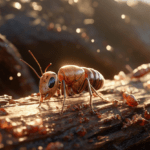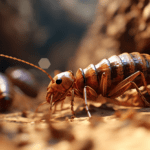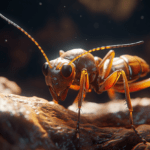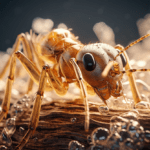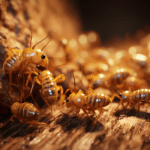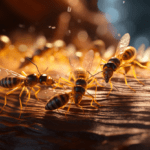Termites, small insects known for their destructive nature, can wreak havoc on properties and cause significant damage if not addressed promptly. While they may appear harmless, their insatiable appetite for cellulose makes them a formidable opponent. This article aims to shed light on the types of termites, their diets, and what attracts them to properties.
Note: Curious about the general diet of termites? Dive deeper into our previous article on What Do Termites Eat? to get a comprehensive understanding.
1. Types of Termites
Termites can be broadly categorized into three main groups: subterranean, drywood, and dampwood termites. Subterranean termites are the most common and cause the most damage. Drywood termites, on the other hand, infest dry wood, while dampwood termites prefer moist environments.
2. Diet of Different Types of Termites
Termites feed primarily on cellulose, a component found in plant materials such as wood. Depending on their species, termites have specific dietary preferences. Subterranean termites, for instance, consume softwood, often found in construction materials. Drywood termites have a preference for hardwood, while dampwood termites thrive in moist and decaying wood.
3. Impact of Termites on Wood
Termites are notorious for their ability to degrade wooden structures. As they feed on cellulose, they create tunnels and galleries within the wood, gradually weakening its integrity. Over time, this can lead to structural damage, compromising the stability of buildings and causing costly repairs.
4. Effects of Termites on Other Food Sources
Termites aren’t limited to wooden structures; they can also target other food sources. They have been known to damage crops, paper products, and even insulation material. It is essential to identify and eliminate termite infestations promptly to protect not only properties but also other vulnerable items.
5. What Attracts Termites to a Property
Several factors can make a property an attractive target for termites. These include:
– Moisture: Termites are drawn to damp and moist areas, as they require water to survive.
– Wood Types: Certain types of wood are more susceptible to termite infestation, such as cedar and pine.
– Landscaping: Trees and shrubs near the property can serve as bridges for termites to access buildings.
– Cracks and Gaps: Openings in foundations, walls, or roofs provide entry points for termites.
6. Damp and Moist Areas
Termites thrive in environments with high moisture levels. Leaky pipes, improper drainage, and condensation issues can create the perfect breeding ground for these pests. Regular inspections and prompt repairs of any water-related issues can help prevent termite infestations.
7. Wood Types
Different wood types vary in their susceptibility to termites. Softwoods, such as pine and spruce, are particularly attractive to termites due to their high cellulose content. Hardwoods, like oak and cherry, are more resistant but not entirely immune to these pests.
8. Dealing with Termite Infestation
Detecting and dealing with termite infestations promptly is crucial. Consulting a professional pest control expert is often the best course of action. They can assess the extent of the infestation, recommend appropriate treatment methods, and implement preventive measures to minimize future risks.
9. What Do Termites Eat: Key Takeaways
- Termites feed on cellulose found in plant materials, primarily wood.
- Subterranean termites prefer softwood, while drywood termites target hardwood.
- Dampwood termites thrive in moist and decaying wood.
- Termites can also damage crops, paper, insulation, and other cellulose-containing materials.
10. Understanding Termite Diets: FAQs
Q1: Can termites eat through concrete?
A1: No, termites cannot eat through concrete. However, they can exploit cracks or gaps in concrete to access wood or other cellulose sources.
Q2: How can I make my property less attractive to termites?
A2: Keeping your property dry, addressing plumbing leaks promptly, and ensuring proper ventilation can help discourage termite activity.
Q3: Are there any natural repellents for termites?
A3: While some essential oils and plant extracts may have repellent properties, professional pest control methods are generally more effective for termite control.
Q4: How fast do termites consume wood?
A4: The rate at which termites consume wood depends on various factors, such as colony size and wood moisture content. However, they can cause significant damage over time if left unchecked.
Q5: Can termites infest furniture?
A5: Yes, termites can infest wooden furniture if they find their way into your property. Regular inspections and preventive measures can help avoid such infestations.
What Attracts Termites to Your Home?
[youtube v=”77zeV-IX93o”]
Termites are a common problem that homeowners face, especially during late spring and summer when they become more active and start swarming. It is crucial for both new and current homeowners to understand what makes their homes attractive to termites and learn how to prevent infestations and costly repairs.
Termites are attracted to light sources
During their swarming period, termites are drawn to light sources such as porch lights, street lamps, and other fixtures. To deter them from your property, it is recommended to keep outdoor lighting shut off at night and secure your windows with light-blocking curtains. This way, termites will be drawn to other properties that have light sources, keeping them away from your home.
Yards with wood-related attractions
Termites are particularly attracted to yards that contain dead trees, stumps, decaying wood structures, and piles of firewood. Since termites rely on wood for their diet and moisture for survival, these wood sources become ideal for them to lay their eggs near or underneath. To prevent termite infestations, it is essential to remove tree stumps and decaying wood completely from your yard. Additionally, movable wood sources like firewood should be stored as far away from your home as possible. Placing concrete slabs underneath the wood or using metal stands to elevate it from the ground can also help prevent infestations from spreading.
Moisture attracts termites
Damp wood termites and formosan termites rely on moisture to digest their food. It is important to examine your property for stagnant water or other sources of moisture, such as leaky pipes, faulty plumbing, air conditioning vents, and rain gutters. Any leaks or faulty plumbing should be repaired promptly, and drains and gutters should be directed away from your home’s foundation to reduce moisture in the area.
Mulch and flower beds as termite hotspots
Mulch and flower beds provide the essential food and water that termites need to survive. Additionally, mulch creates a damp and dark environment that is conducive to termite and larval development. Ideally, mulch and flower beds should be established several feet away from your home. Consider using materials like gravel that termites cannot ingest. This helps create an environment that is less attractive to termites.
Treating and monitoring termite activity
If you have already found termites inhabiting your yard or structure, a trench application with a termiticide like Taurus SC is recommended. Taurus SC is a non-repellent termiticide that provides residual control over termites and other pests. The mix rate of this product may vary depending on the severity of the infestation. To use this product, dig a trench 6 inches wide and 6 inches deep, mix the solution, and pour it directly into the trench. Use 4 gallons of solution to treat every 10 feet of length. After treatment, monitor for further activity using red eye termite monitoring stations. Once termite activity is confirmed, you can treat infesting termites by injecting a product like Fibrofoaming Aerosol into the station.
Remove wooden debris and maintain a well-kept lawn
In addition to mulch and flower beds, overgrown brush, shrubs, and trees can attract termites to your home. These serve as bridges for termites, leading them directly to where they want to be. To prevent termites from spreading this way, it is important to pick up any fallen branches and other wooden debris on your property. Trimming away tree branches that hang over your roof and keeping shrubbery at a suitable distance from your home can also help. Proper lawn maintenance, including regular mowing to the appropriate height, can prevent termites and other pests from spreading.
Taking preventive measures to avoid termite infestations is crucial for homeowners. By following these tips and using professional products like those offered by Solutions Pest and Lawn, you can protect your home from termites. Fast and free shipping options are available to help you get control quickly. Visit their website to get the necessary products today and prevent costly termite damage. Don’t forget to share this helpful guide and subscribe to the Solutions Pest and Lawn channel for more how-to and product videos. Contact them for additional tips, tricks, and DIY pest solutions.
Conclusion
Understanding the diet and habits of termites is crucial for protecting properties from their destructive nature. By addressing moisture issues, choosing the right wood types, and promptly dealing with infestations, homeowners can minimize the risk of termite damage. Professional pest control assistance should be sought when necessary to ensure effective and long-lasting termite control.
- Crypto Quotes’ Red Flags: Avoid Costly Mistakes - June 30, 2025
- Unlock Inspirational Crypto Quotes: Future Predictions - June 30, 2025
- Famous Bitcoin Quotes: A Deep Dive into Crypto’s History - June 30, 2025

